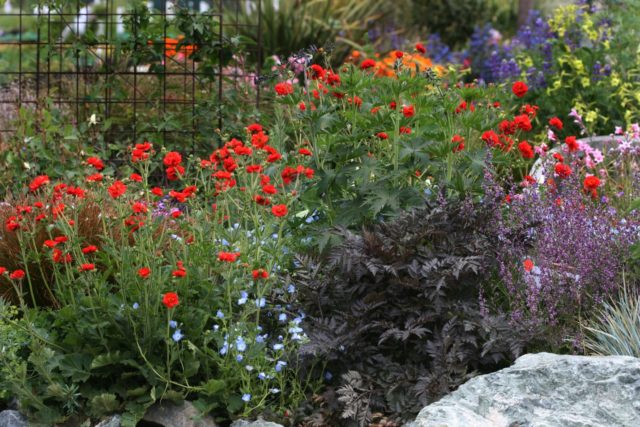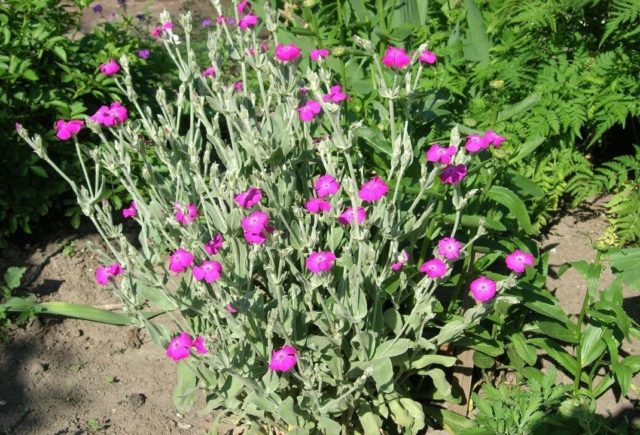Content
Lychnis crown is a small but bright flower that has won the hearts of many lovers of ornamental garden plants. Red petals literally glow against the background of bluish stems and leaves. No wonder its name translated from Greek means “light, lamp.”
History of appearance
Another name for the flower is leathery adonis. It received its international name back in 1792. It is generally accepted that it appeared in the Crimea and Transcaucasia. Brought to Russia from southern Europe.
Popularly, Lychnis crownata was called “soapweed.” Its petals and rhizomes are distinguished by good soapiness; in the past it was often used for washing. The crop has long been grown in North America and the Old World.

Two varieties are widespread in our country - crowned lychnis and chalcedony
Description and characteristics
Crown lychnis, or Lychnis coronaria, is a perennial from the Carnation family, genus Smolevka.However, in the literature there is often information that it is a biennial, since in our country it grows for no more than 2 years.
Adonis is a low, dense and lush herbaceous plant up to 1 m high. It has straight and curved whitish branched stems. Small leaves about 10 cm long, greenish-silver in color, have an oblong-lanceolate shape at the basal rosettes, and oval on the shoots. The stems and leaf blades have a velvety surface. Thanks to the large number of branched shoots, crown lychnis acquires a decorative appearance.
The flowers are round in shape, 3-4 cm in size and have orange, crimson, pinkish, white and reddish shades. Thanks to breeding work, the color can be varied and even two-color; varieties can be double. This makes Lychnis popular among amateur gardeners and landscape designers. The flowers have 5 petals, an obovate-shaped calyx and a raspberry-pink corolla. After blooming, the buds gradually turn out and droop downwards.
Flowering occurs in early summer and continues until the end of autumn. Some varieties have buds that bloom later. At the end of the growing season, crown lychnis does not lose its beauty. Against the background of silvery foliage, individual bright “lights” continue to appear. When cold weather sets in, the flowers fade, their number decreases, but remain as bright as in summer.
Lychnis crown is a light-loving plant. It needs good lighting and blooms only in the sun.Without it, the crop grows a large number of leaves and shoots. Otherwise, adonis is undemanding to growing conditions. It tolerates strong winds, precipitation and temperature changes well.

To extend flowering for several weeks, gardeners advise removing dried petals in a timely manner.
Varieties of Lychnis crown
Thanks to the efforts of breeders, there are many varieties of crown lychnis. The following are especially common in garden plots and city flower beds:
- Angels Blush is a biennial plant up to 60 cm high. The highlight of the variety is its color. Immediately after blooming, the flowers of Lychnis crownata acquire a white tint, and then gradually change it to pink.
- Atrosanguinea is a species of Lychnis crown that grows up to 1 m in height. It has beautiful flowering. The petals are bright red, attracting butterflies, bees and other insects. The peculiarity of the variety is its undemandingness to temperature and soil composition.
- Mysterious Island is a perennial variety of Lychnis crown, bred by domestic breeders. It grows in one place for up to 5 years. It has small red or crimson flowers. Does not require careful care, tolerates cold weather well.
- Gartner Wonder (Gartner Wonder) was launched in Europe. A distinctive feature of the variety is double flowering. Its petals are located at the tops of the shoots, twisted into tubes, and painted scarlet.
Methods for propagating Lychnis crownata
Adonis can be propagated by seeds, as well as by vegetative methods, primarily by cuttings. The methods have their own characteristics and are used in different periods of time.
Seeds
Lychnis crown is able to reproduce independently, that is, by self-sowing. The seeds fall out, go deeper into the soil and remain there for the winter. With the onset of spring, young shoots form. Flower growers only need to choose the strongest and healthiest among them and plant them.
If you purchase seeds of a certain variety in a store, it is recommended to sow them in open ground in April. Focus on air temperature. It should be between +18 and +21 degrees.

Lychnis crown can be sown in the ground after night frosts have passed.
The seeds are planted in prepared grooves and lightly sprinkled with soil. If necessary, cover with film. The first shoots appear after 3 weeks. They are subsequently picked off.
Sowing of Lychnis coronata for seedlings is carried out in late February - early March. They are first placed in the refrigerator for 30 days for stratification. Then prepare the containers and fill them with light nutrient soil. Sow seeds, cover with soil and cover. The plantings are ventilated every day.
Lychnis crown is transferred to open ground with the onset of summer.
Cuttings
Another effective method of propagating a crop is cuttings. It is carried out as follows:
- Choose strong shoots 15-20 cm long. Do this in June.
- On mother plants, cuts are treated with charcoal or garden pitch.
- The cuttings are deepened into the soil.
- Moisturize regularly.
- New plants are moved to a permanent location with the onset of autumn.
Flower growers resort to cuttings less often than to the seed propagation method. The latter is considered simpler and more effective.
Planting and caring for Lychnis crown
Growing a crop does not require much effort or knowledge; even beginners in floriculture can cope with this task. The first thing you should pay attention to is the area for Lychnis crown. It should be open, located in the sun.
The soil should be light. It is recommended to prepare the soil for adonis in advance: dig it up, saturate it with sand, humus or superphosphate. Landing is carried out as follows:
- Make small holes.
- A drainage layer, such as gravel or small pebbles, is placed at the bottom. Add soil.
- Place young plants in planting holes and dig in.
- The soil is compacted and watered generously.
Further care mainly consists of watering and fertilizing. Lychnis crown does not require frequent moistening. The only exceptions are hot, dry days. The rest of the time, watering is carried out once a week.

Overwatering threatens the health of Lychnis crownata no less than drought
Fertilizing is necessary for the crop to stimulate flowering. It is recommended to apply fertilizers twice a season - before the formation of buds and at the time of active flowering. For the first time, you can feed Lychnis crown with a mixture of potassium sulfate, urea and superphosphate. These substances are taken a tablespoon at a time and dissolved in a bucket of water. When the plant blooms, superphosphate can be used as fertilizer. Solutions are poured at the root.
Preparing Lychnis crown for wintering is as follows: loosen the soil around it and remove weeds. The above-ground part of the bushes is completely cut off.Rhizomes tolerate cold well, especially if the winter turns out to be snowy. Otherwise, the adonis is covered with spruce branches.
Pests and diseases
Adonis is susceptible to attacks by certain insect pests:
- spider mite;
- aphid;
- leaf roller.
At the initial stage of infection, Lychnis crown can be treated with a soap solution. Subsequently, acaricides and insecticides should be used.
Common diseases of adonis are root rot, rust, spotting. Fungicides are used for prevention and treatment. In case of serious damage, diseased specimens are destroyed to save the rest.
Lychnis crown in landscape design
Leathery adonis can decorate any area. It is actively used by landscape designers. And gardeners love it for its decorativeness and unpretentiousness. The flower can be planted on alpine hills, flower beds, and near ponds. Plants look good not only as part of compositions, but also as independent plantings.
In the photo, crown lychnis looks great in the vicinity of many crops, for example, chrysanthemums, asters, carnations, violets, garden varieties of daisies, and bells.

Beautiful compositions include adonis with lobelias and gypsophila
Conclusion
Lychnis crown is a godsend for beginners and experienced gardeners. Without requiring special attention, it decorates the garden with bright flowers, like many small lights. The velvety, silvery leaves and stems also have a decorative appearance.












